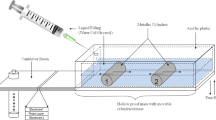Abstract
Piezoelectric materials convert mechanical deformation directly into electrical charges, which can be harvested and used to drive micropower electronic devices. The low power consumption of such systems on the scale of microwatts leads to the possibility of using harvested vibrational energy due to its almost universal nature. Vibrational energy harvested using piezoelectric cantilevers provides sufficient output for small-scale power applications. This work reports on vibrational energy harvesting from free-falling droplets at the tip of lead zirconate titanate piezoelectric-based cantilevers. The harvester incorporates a multimorph clamped–free cantilever made of lead zirconate titanate piezoelectric thick films. During the impact, the droplet’s kinetic energy is transferred to the form of mechanical stress, forcing the piezoelectric structure to vibrate and thereby producing charges. Experimental results show an instantaneous drop-power of 2.15 mW cm−3 g−1. The scenario of a medium intensity of falling water drops, i.e., 200 drops per second, yielded a power of 0.48 W cm−3 g−1 per second.
Similar content being viewed by others

Abbreviations
- α :
-
Constant relating electric current to strain rate
- ε :
-
Dielectric constant
- σ in :
-
Input stress
- ω :
-
Radial frequency
- a :
-
A constant being either 1 or 2 depending on the wiring of the harvester
- c p :
-
Young’s modulus of the piezoelectric material
- C b :
-
Capacitance of the piezoelectric bender
- C k :
-
Equivalent capacitance representing mechanical stiffness
- d 31 :
-
Piezoelectric strain coefficient
- i :
-
Electric current
- j:
-
Complex number (i.e., the square root of −1)
- k 31 :
-
Piezoelectric coupling coefficient
- l e :
-
Length of the electrode in the piezoelectric harvester
- L m :
-
Equivalent inductance representing mass
- n :
-
Turns ratio
- R :
-
Load resistance
- R b :
-
A resistor representing mechanical damping
- R opt :
-
Optimum resistance
- S :
-
Strain
- t p :
-
Thickness of the ceramic/piezoelectric material
- t sh :
-
Thickness of the shim material
- V :
-
Voltage
- w :
-
Width of the ceramic/piezoelectric material
- Z in :
-
Input impedance
References
Y.K. Tan, Sustainable Energy Harvesting Technologies—Past, Present and Future (Rijeka: InTech, 2011), pp. 1–23.
M. Al Ahmad, A.M. Elshurafa, K.N. Salama, and H.N. Alshareef, Smart Mater. Struct. 20, 5001 (2011).
A. Harb, Renew. Energy 36, 2641 (2011).
M. Lallart and D.J. Inman, J. Korean Phys. Soc. 57, 947 (2010).
R. Guigon, J.-J. Chaillout, T. Jager, and G. Despesse, Smart Mater. Struct. 17, 7 (2008).
M. Al Ahmad and G. Jabbour, J. Electron. Lett. 48, 647 (2012).
A. Fernandes and J. Pouget, Eur. J. Mech. A: Solids 21, 629 (2002).
J. Mattey, Piezoceramic Masses Technical Data, Redwitz. www.piezoproducts.com. Accessed 20 October 2013.
W.G. Cady, Piezoelectricity, 1st ed. (New York: McGraw-Hill, 1946).
APC International Ltd., Piezoelectric Ceramics: Principles and Applications (Mackeyville, PA: APC International Ltd., 2002).
S. Roundy and P.K. Wright, Smart Mater. Struct. 13, 1131 (2004).
Author information
Authors and Affiliations
Corresponding author
Rights and permissions
About this article
Cite this article
Al Ahmad, M. Piezoelectric Water Drop Energy Harvesting. J. Electron. Mater. 43, 452–458 (2014). https://doi.org/10.1007/s11664-013-2826-2
Received:
Accepted:
Published:
Issue Date:
DOI: https://doi.org/10.1007/s11664-013-2826-2



